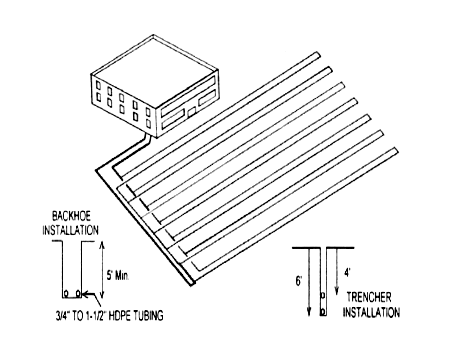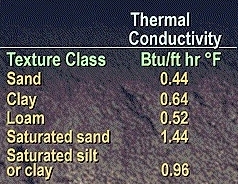
Technical Information on Horizontal Closed Loops

Here is a clear image of a horizontal closed loop geothermal heating and cooling system.
It is installed by using a backhoe, not by drilling deep wells.
Thanks to research data at the University my niece Katie attends: Virginia Tech.
http://geothermal.geol.vt.edu/
Everyone asks what the temperature of the ground is.
This map shows ground and well water temperatures.
Here in Litchfield, it averages about 50 degrees.

Of course we do not bring 50 degree temperature into the house and use it alone.
We run the 50 degree water through a heat pump that Connecticut Licensed Heating Contractor Carl describes simply as sort of a reverse refrigerator.
By compressing Freon, we draw heat from the 50 degree water, and return it to the underground pipe at say 40 degrees.
For cooling, we reverse the hybrid heat pump, and return it to the underground pipe at 60 degrees.
By the time the pipeline water completes its 730 foot long underground loop and returns for more heat pump use, it is back to its 50 degrees or so.
This will service the 2000 square foot first floor for cooling and heating,
- replacing the 2 1/2 ton air conditioner, and that portion of our fuel oil boiler that heats downstairs.
Note that the loops are smooth to minimize head loss friction on the circulating pump.
The loop does not go near the underground electric lines, the water or sewer lines, near big tree roots, etc.
More from Virginia Tech, showing that by digging deeper below frost levels, a more consistent temperature is reached year round.

While Virginia is warmer than Litchfield at 62 degrees where tested,
the same benefits can be achieved by digging deeper.
The old 42" frost design depth for footings is now 48" in New York, and should be used in Connecticut for this.
The geothermal system would work even in the frost layer, but it would lose efficiency.
Air heated and cooled heat pumps are thus much less efficient than water loops.
The electric bill to circulate the water is minimal, and dependent on design.
Perhaps someday we will afford solar panels to electrify the heat pump, but at $750 for 136 watts,
I'd rather invest in geothermal horizontal loops. Large scale projects with utility/government subsidies are different.
Remember, turning electricity into air conditioning with an inefficient AC unit is a lot more expensive than using ground coolness.
Turning fuel oil into heat is a lot more expensive than using ground heat.

Compare to other materials here.
Litchfield is founded on deep Paxton and Woodbridge soils.
When we drilled our well, we went 60' to ledge.
So we know we can achieve a good depth to install our loop.
Do you know if you have good deep soils under your lawn?
Can you stay away from your primary septic system?
Here are other technical links: (or use Google)
http://www.geokiss.com/info-kit.htm
http://stores.channeladvisor.com/IWAE/items/item.aspx?itemid=77549
http://www.informedbuilding.com/Geothermal/Main16/Types-of-Geothermal-Ground-Loops/
http://geothermaldiy.com/estimates.html
http://geoexchange.org/forum/announcement.php?f=110/publications/connecticut.htm?b78a3980
http://www.iecouncil.org/Fact%20Sheets/Geothermal%20Closed-Loop%20Heat%20Pump.pdf
http://www.soundgt.com/earth.htm
http://www.eere.energy.gov/consumer/your_home/space_heating_cooling/index.cfm/mytopic=12670
Design references:
There are many local links to geothermal you can see from Google.
This is the State of Connecticut report that Torrington Area Health District told me about in mid April.
http://www.ct.gov/dph/lib/dph/governmental_relations/2007reports/geothermal_well_report.pdf
Note that the regulations have not been passed, but these recommendations are what I follow for horizontal loops.
Thank you to the Connecticut Well Drillers Association for working with the DEP to establish criteria for wells.
Although the horizontal looping is not similarly regulated, it benefits from the work by those groups.
For confined lots, where well drilling is feasible, the closest contact is Wragg Well Drilling in Roxbury, CT, Grella Well Drilling in Terryville, and Connecticut Wells in Bethlehem.
The claim is that by drilling two wells, and taking fresh water out and into your home, and expending it into a second well (open loop) saves 15% efficiency.
So decide if the investment cost for
wells (in the $30,000 range with heat pump and guarantees, etc is worth the
savings. in your electric bill.).
But for areas where soils are deep, you can save drilling and bentonite costs,
and install a horizontal system.
For library lecture:
Fuel Mix Reference:
www.ctcleanenergyoptions.com/calculator6.php
Just to put residential climate control energy use into perspective:

Back to Index page